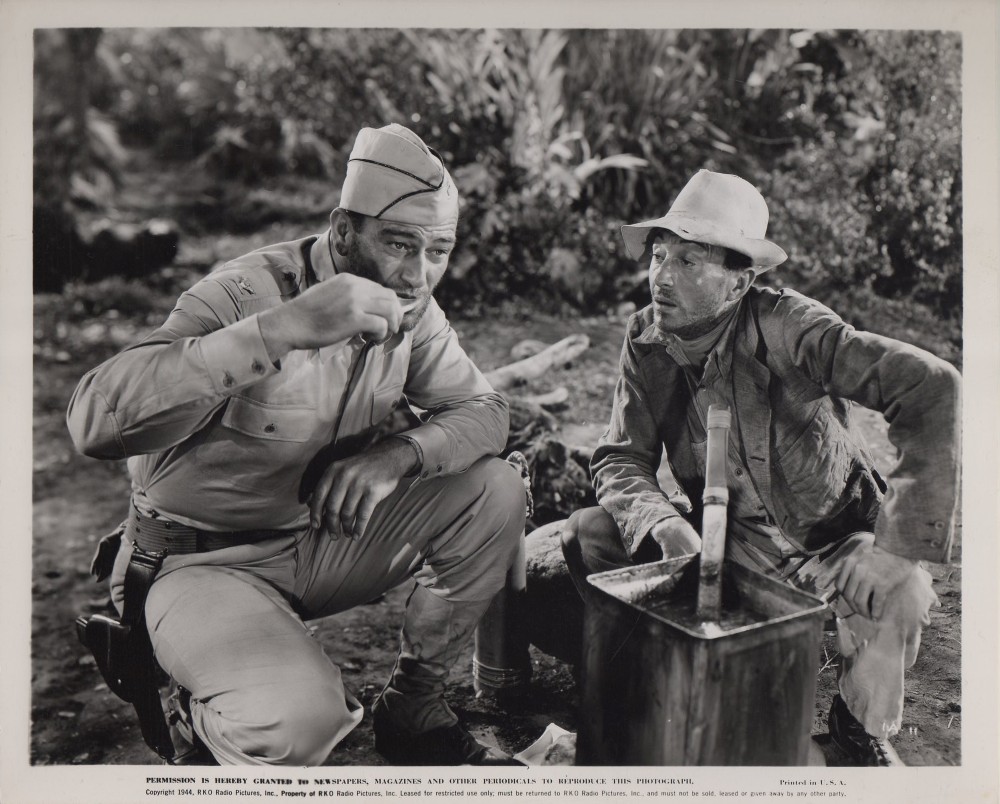BACK TO BATAAN
DIRECTED BY EDWARD DMYTRYK
PRODUCED BY ROBERT FELLOWS/ THERON WARTH
MUSIC BY ROY WEBB
RKO RADIO PICTURES
 Photo with the courtesy of lasbugas
Photo with the courtesy of lasbugas
Information from IMDb
Plot Summary
After the fall of the Philippines to the Japanese in World War II,
Col. Joseph Madden of the U.S. Army stays on
to organize guerrilla fighters against the conquerors.
Full Cast
John Wayne .... Col. Joseph Madden
Anthony Quinn .... Capt. Andrés Bonifácio
Beulah Bondi .... Bertha Barnes
Fely Franquelli .... Dolici Dalgado
Richard Loo .... Maj. Hasko
Lawrence Tierney .... Lt. Cmdr. Waite
Philip Ahn .... Col. Coroki
'Ducky' Louie .... Maximo Cuenca
Leonard Strong .... Gen. Homma
Paul Fix .... Bindle Jackson
Abner Biberman .... Japanese captain at schoolhouse
Vladimir Sokoloff .... Señor Buenaventura J. Bello
Alex Havier .... Sgt. Bernessa (as J. Alex Havier)
John Miljan .... Gen. Jonathan Wainwright ('Skinny')
Harold Fong .... Prince Ito
Benson Fong .... Officer making broadcast
Erville Alderson .... (uncredited)
Robert Clarke .... Soldier (uncredited)
Edmund Glover .... (uncredited)
Kenneth MacDonald .... Maj. McKinley (uncredited)
Michael Mark .... Chief of Police (uncredited)
Ray Teal .... Lt. Col. Roberts (uncredited)
Bill Williams .... (uncredited)
Writing Credits
Ben Barzman (screenplay) and
Richard H. Landau (screenplay)
Æneas MacKenzie (original story) (as Aeneas Mac Kenzie) and
William Gordon (original story)
Original Music
Roy Webb
Cinematography
Nicholas Musuraca (director of photography)
Trivia
As the script for the movie was being written, the battle for Bataan was still being fought. The screenwriters were constantly updating the script based on the latest news from the front.
The character Andres Bonifacio played by Anthony Quinn is supposed to be the grandson of Andres Bonifacio, a leader of the Philippine revolt against Spain in the late 19th century. The real Andres Bonifacio's only child died of smallpox, so he had no grandchildren.
The first 10 notes of "Lupang Hinirang", the Philippine National Anthem was played during the vehicular ambush scene against the Japanese by the Philippine Guerrillas
The Bataan of the film's title refers to both the World War II Battle of Bataan and the place Bataan which is a Central Luzon region province on Luzon island in the Philippines which occupies the whole of the Bataan Peninsula on the island.
This is one of a handful of feature film movies that have featured the story of the World War II Battle of Bataan. They include Bataan (1943), So Proudly We Hail! (1943); They Were Expendable (1945) and Back to Bataan (1945).
The movie took one hundred and thirty days to shoot the picture, i.e. about one third of a year or four months.
As John Wayne refused to use a stunt-double in the movie, director Edward Dmytryk and screenwriter Ben Barzman wrote scenes for Wayne with dangerous stunts so that Wayne would want to use a stuntman. Not even this deterred Wayne who still did the stunts.
The state of the war in World War II was an ever-changing dynamic and two thirds of the way through production, the American invasion of the Philippines took place. As such, script changes and re-writes needed to be made to keep up to date with the current status of the war.
Goofs
* Revealing mistakes: Plugs can be seen in the barrels of the Thompson sub-machine guns which make them fire fully automatically with blank rounds.
* Miscellaneous: When the Australian radio officer types the message he's receiving from the Phillippines, he spells the word "organization" using the American spelling, with a "z". An Australian would use the British spelling - "organisation", with an "s" - although it is possible he simply wrote "z" because he was quickly transcribing the Morse Code signal sent by the Americans.
* Revealing mistakes: A long shot of the truck carrying the Japanese soldiers and the boy Maximo driving along the mountain road is repeated twice (the truck is seen passing in front of a hill headed toward the right of the screen, then the same shot is repeated a few seconds later).
* Revealing mistakes: Miss Barnes asks Col. Madden if, after he avenges the hanging of Senor Bello, he would erect a sign in his honor quoting a Filipino poem that mentions several kinds of trees, including a cypress. Madden and his men do so, but the on the sign the word cypress is erroneously spelled "Cyprus", like the Mediterranean island.
* Factual errors: When we first see Miss Barnes addressing her school, she says that the agreement between the United States and the Philippines had set the date of Philippine independence for July 4, 1946. In fact, the original 1936 agreement between the two countries had set the date of Filipino independence for 1944. But the advent of World War II made it necessary to delay independence until after the war was over. The Philippines did become independent on July 4, 1946, but that was not the date set in the agreement Miss Barnes alluded to.
* Continuity: During the climatic battle, we see Quinn crawling through the mud with his Thompson as a Japanese truck is bearing down on him. Wayne peppers the truck with machine gun fire, causing it to crash. A second later you see Quinn join up with Wayne and he's perfectly clean.
* Factual errors: Imperial General Headquarters regarded Homma as not aggressive enough in war (resulting in the high cost and long delay in securing the American and Filipino forces' surrender), and too lenient with the Filipino people in peace, and he was subsequently removed from his post on June 9th 1942 and returned to Japan. In the movie when they are discussing the possibility of Filipino independence with Dalisay Delgado, Homma, would have been in Japan at this point in time.
Memorable Quotes
Filming Locations
Philippines
Tarzana Ranch, Thousand Oaks, California, USA
Watch this Trailer
[extendedmedia]
[/extendedmedia]
Previous discussion:-
Back To Bataan


